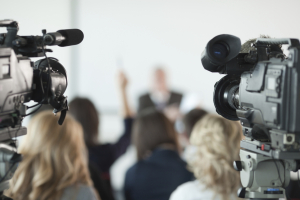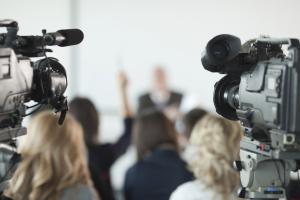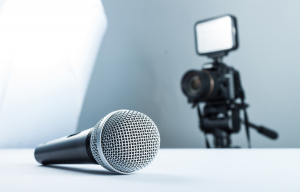-
.
Displaying items by tag: media training
Media Training: Balancing Warmth and Authority – The Presenter Studio
One of the most challenging skills to master in media training is finding the right balance between warmth and authority. Lean too far into authority and you risk sounding cold, unapproachable, and overly corporate. Focus only on warmth and you might come across as lacking in credibility or gravitas. The art lies in blending the two so they work together.
Audiences want to feel reassured that you know your subject — but they also want to feel a human connection. Authority gives you trust; warmth keeps people engaged. In presenting, these qualities are not opposites. In fact, the best communicators make them inseparable.
Think of an experienced news anchor. They speak with the weight of knowledge and the assurance of experience, yet they deliver their words with empathy. They are confident without arrogance, friendly without being casual to the point of losing professionalism.
Achieving this balance starts with self-awareness. Media training helps you identify whether your natural style leans more towards warmth or authority. Once you know this, you can develop the complementary side. If you’re naturally warm, you can work on tightening your structure and boosting your vocal power. If authority is your strength, you can bring in more openness, conversational language, and visual engagement.
The goal is to create a style where the audience feels both guided and welcomed. When warmth and authority work in harmony, your message not only lands — it sticks.
https://www.presenterstudio.com/business-presenter-training/media-training
Media Training Tip: Why Less is More – The Presenter Studio
One of the golden rules of media training is simple: less is more. Too many presenters — whether they are new to the industry or seasoned professionals — fall into the trap of overexplaining. They circle around their point, padding every sentence with unnecessary words until the original message is lost in the fog.
The problem with waffle is that it forces your audience to work harder. They have to sift through the clutter to find the value. And in today’s media landscape, where attention spans are short and competition for viewers is fierce, you can’t afford to lose people in the first few seconds.
Great presenting is about clarity. It’s about choosing the one key idea you want to land and delivering it with precision. Think of your words like high-quality ingredients — you don’t need to drown them in sauce.
When you cut the waffle, your delivery gains energy. Your key messages stand out. Your audience feels respected because you value their time. This doesn’t mean stripping away your personality or warmth — it means using those elements more effectively. The tighter your delivery, the greater the impact.
Media training helps you spot the unnecessary words, the tangents, and the filler that creep into your speaking style. Once you remove them, you’ll discover that you not only sound more confident — you are more confident. And that confidence is what your audience will remember.
Find out how we can help you craft your message: https://www.presenterstudio.com/business-presenter-training/media-training
Media Training: Why Finding Your Own Voice Matters – The Presenter Studio
In media training, one of the most important lessons you can learn is the value of finding your own voice. Recently, I saw a post from a presenter trainer promoting her services. She spoke with precision, every word placed as if it had been measured against a ruler. The delivery was reminiscent of the Queen’s Speech: formal, deliberate, and entirely disconnected from the real human rhythm of conversation. It was polished to the point of sterility.
This kind of presentation might seem impressive on the surface, but it doesn’t work for television, online video, or live speaking. Audiences connect with people, not performances. If your style is overly rehearsed, every sentence perfectly clipped and polished, you risk coming across as cold and inaccessible.
Finding your own voice is not about discarding professionalism — it’s about bringing your personality into the way you speak. Your voice should carry your experiences, your sense of humour, your pace, your natural quirks. When you speak like yourself, people believe you. They feel they are being addressed directly, not spoken at from behind a glass screen.
This is the real skill of media training: to take what makes you you and turn it into something that feels effortless, even in high-pressure situations. The most engaging presenters sound like they’re talking just to you, not delivering a lecture to the masses. When you find your voice, you not only keep your audience listening — you give them a reason to come back.
Podcast interview with Presenter Trainer Gareth - The Presenter Studio
Our own Gareth had a great chat on the Chatterbeans podcast recently. Talking all things presenting, TV and career.
Take a look here: https://www.chatter-beans.com/latest-episodes
It was so much fun to do!
How to Sound Natural and Confident on Camera
The camera can be intimidating. Even the most confident professionals sometimes freeze or go into performance mode when the red light comes on. But the best media interviews don’t feel performed — they feel real.
So how do you sound natural on camera? The key is to speak like a person, not like a press release. Media training helps you find the balance between professionalism and personality. It’s not about being perfect — it’s about being you, with polish.
Start by knowing your talking points. If you’re clear on what you want to say, you can relax and have a conversation — instead of worrying about getting it right.
Next, think about pace and tone. People often speed up when they’re nervous, which can make you seem rushed or robotic. Slow down just a little, and let your tone be friendly and expressive. It’s okay to smile and show warmth — it helps the audience connect.
Eye contact is also key. If you’re on live TV or doing a recorded interview, keep your eyes on the interviewer or the lens, whichever is appropriate. Avoid darting around or looking distracted. The more grounded you are, the more confident you’ll appear.
Ultimately, great media interviews don’t happen by chance. They’re the result of preparation, practice, and knowing how to bring your best self to the screen.
For more information about our training programmes visit: https://www.presenterstudio.com/business-presenter-training/media-training
Why Media Training Is Essential for Modern Professionals
In today’s fast-moving digital world, the media can be your greatest opportunity — or your biggest risk. That’s why media training is no longer just for celebrities or politicians. It’s a vital skill for anyone representing a brand or business.
When you're being interviewed, how you say something matters just as much as what you say. Media training helps you learn how to deliver your message clearly, confidently, and with purpose — whether it's on camera, in print, or across social media.
It also prepares you for pressure. Interviews can be unpredictable, and without the right tools, it’s easy to get thrown off track. Media training teaches you how to stay calm, avoid being misquoted, and handle difficult questions with professionalism.
Most importantly, it helps you speak like a real person. Audiences connect with authenticity — not jargon or rehearsed statements. Great media interviews feel conversational, natural, and honest.
If you're a business leader, spokesperson, or expert in your field, media training should be part of your professional toolkit. It's about protecting your brand, owning your story, and making your voice count.
For more information about our training programmes visit: https://www.presenterstudio.com/business-presenter-training/media-training
Use Silence to Speak with Impact - Media Interview Techniques
Why Energy Matters in Media Interviews - Media Training Tips
When it comes to media training, people often focus on what they say. But how you say it is just as important. And that’s where energy comes in.
Energy isn’t about being loud or over the top—it’s about showing that you care. When your voice has life, your eyes are engaged, and you’re actively involved in the conversation, the audience is far more likely to trust and believe you.
TV and radio have a way of flattening everything. So the energy you feel on the inside often doesn’t come across unless you deliberately turn it up a notch. That’s why media training sessions often feel like performance coaching. You need to lift your delivery, bring pace and contrast, and make sure your enthusiasm shines through.
This is especially true if the topic is serious or technical. Energy is what cuts through. It makes people want to listen. And crucially, it makes you feel more confident too.
So next time you’re prepping for an interview, don’t just script your message. Rehearse how you’re going to deliver it—with the energy it deserves.
For more information about our training programmes visit:
https://www.presenterstudio.com/business-presenter-training/media-training
Media Training - Wear Something That Reflects the Tone and Feel of Your Brand
In media appearances, how you look matters – not just in terms of style, but in terms of story. Your clothes send a message. They say something before you’ve even opened your mouth. So what are they saying about your brand?
At The Presenter Studio, one of the first things we ask clients is: Does what you’re wearing reflect the tone and feel of your business? For example, if you’re a relaxed, creative founder, a stiff suit might make you look out of step with your brand identity. Equally, if you’re representing a high-end corporate firm, a casual t-shirt might feel off-brand or unprepared.
Your appearance should support – not contradict – your message. It’s not about fashion. It’s about consistency. Colour, texture, formality, accessories – all these elements help create a visual impression that needs to align with how you want to be perceived.
And it’s not just about the brand. It’s about you, too. You need to feel comfortable and confident. Clothes that feel unfamiliar or awkward will impact how you move, how you sit, how you speak. The best on-camera looks are those that make you feel like the best version of yourself.
In our media training at The Presenter Studio, we offer advice not just on performance, but on styling – what works on camera, what to avoid, and how to find the sweet spot between your brand and your personality. Whether it’s a big studio interview or a social media video, we help you look the part and own the room.
To find out more about how we can prepare you for success in the spotlight, head to: https://www.presenterstudio.com/business-presenter-training/media-training
Media Training - Think of the Camera as a Real Person
Facing a camera can feel unnatural. There's no eye contact, no nodding head, no visible reaction – just a black lens staring back at you. It's no wonder many people freeze, overthink their delivery, or come across as wooden on screen. But here’s one of the most effective – and surprisingly simple – techniques we teach at The Presenter Studio: treat the camera as if it were a real person.
Imagine the camera is your best client, your most engaged colleague, or your most supportive friend. The goal is to create a genuine connection. When you shift your mindset away from ‘broadcasting’ and toward ‘communicating’, your tone naturally becomes warmer, your delivery more relaxed, and your performance more authentic.
Why does this matter? Because viewers can instantly tell when something feels rehearsed or robotic. The magic of great on-camera presence lies in making the audience feel like you’re speaking directly to them, not just delivering a message. Eye-line, tone, and intention all improve when you stop seeing the lens as a threat and start seeing it as a human.
At The Presenter Studio, our clients often find that this one mental shift unlocks a whole new level of confidence. We use practical exercises and personalised coaching to help them come across as natural and connected – even when the red light is on.
If you’d like to feel more at ease on camera and learn techniques used by top broadcasters and business leaders, explore our media training services at: https://www.presenterstudio.com/business-presenter-training/media-training











